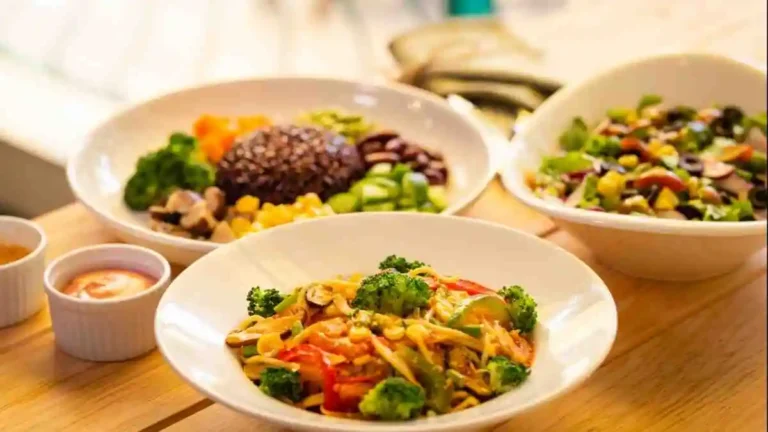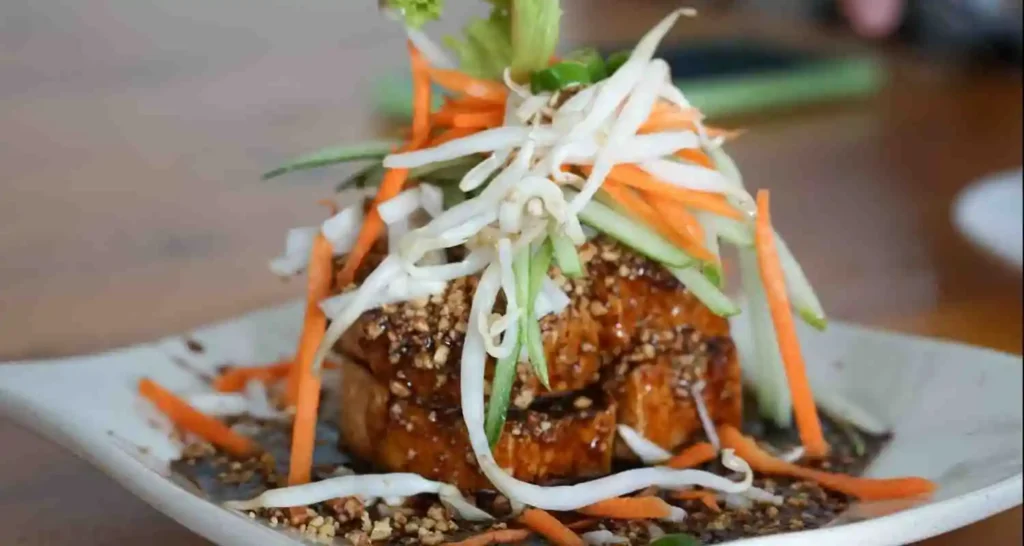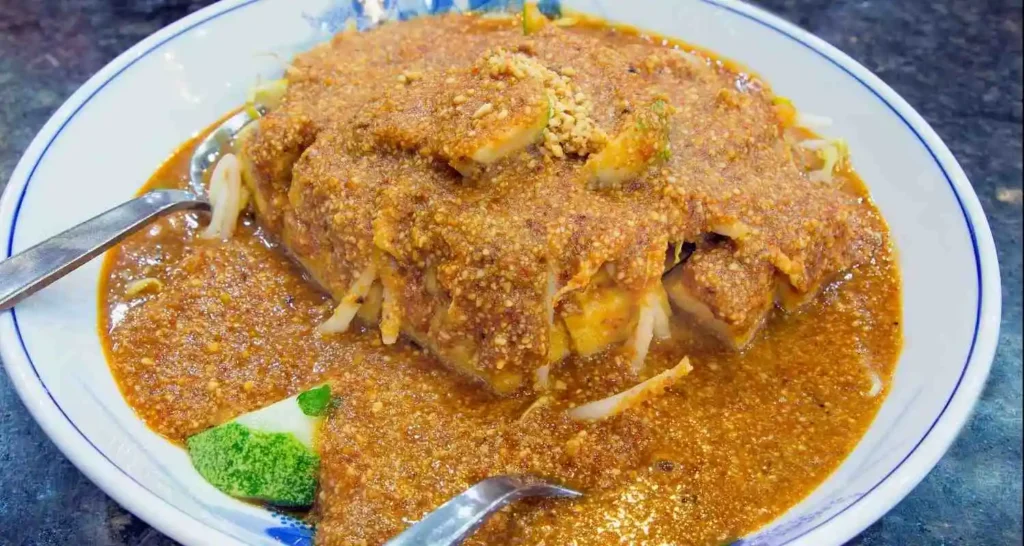Tauhu, better known as tofu in many parts of the world, is a versatile and beloved ingredient in Asian cuisine, prized not only for its ability to absorb flavors but also for its impressive nutritional profile. Made from soybeans, water, and a coagulant, tauhu is a plant-based protein powerhouse that can be used in a myriad of dishes, ranging from simple stir-fries to elaborate stuffed creations. In this blog post, we will delve deep into everything tauhu: from its types and preparation methods to delicious recipes and nutritional benefits. Whether you’re a tofu novice or a seasoned chef looking to expand your tauhu repertoire, this guide will provide you with all the information you need to master tauhu cooking. Let’s embark on this flavorful journey and unlock the secrets of creating delightful tauhu dishes that will tantalize your taste buds.
What is Tauhu?
Tauhu, or tofu as it is widely known outside of Asia, is a soy-based product that has been a staple in Asian diets for centuries. Originating from China, the creation of tauhu is believed to have occurred during the Han dynasty, making it a food with a rich history. Tauhu is made by coagulating soy milk and then pressing the resulting curds into soft, white blocks. This simple yet versatile food can vary in texture and firmness, making it suitable for a wide range of culinary applications—from smoothies to stir-fries.
Types of Tauhu
Tauhu comes in various consistencies, each suited to different types of dishes:
- Silken Tauhu: Extremely soft and smooth, this type is ideal for purees, smoothies, and desserts. Its delicate texture means it must be handled gently to maintain its form.
- Soft Tauhu: Slightly firmer than silken but still quite tender, soft tauhu is great for soups and light simmered dishes where it can absorb flavors without disintegrating.
- Firm Tauhu: With a more substantial texture, firm tauhu holds up well in stir-fries and pan-frying. It’s an excellent meat substitute in vegetarian and vegan dishes.
- Extra Firm Tauhu: The most dense and meaty type of tauhu, extra firm is perfect for grilling or any recipe that requires the tofu to maintain its shape under high heat or heavy handling.
Each type of tauhu serves a specific purpose in cooking, and choosing the right type can greatly impact the texture and outcome of your dishes. Understanding these variations is the first step to mastering tauhu recipes, as it allows you to select the appropriate texture for your cooking needs.
Essential Ingredients for Tauhu Recipes
To bring out the best in tauhu, it’s crucial to pair it with the right ingredients that enhance its natural flavor and texture. Here’s a list of some common ingredients that are often used in tauhu recipes to elevate its taste:
- Soy Sauce: Adds a rich, umami flavor that is almost synonymous with Asian cuisines.
- Sesame Oil: Imparts a nutty aroma and is perfect for seasoning and dressing tauhu.
- Rice Vinegar: Provides a mild acidity that can brighten the overall flavors of the dish.
- Ginger: Offers a spicy, sharp taste that complements the mildness of tauhu.
- Garlic: Adds depth and intensity, which is essential for creating savory tauhu dishes.
- Scallions and Cilantro: These fresh herbs add a burst of freshness and color to tauhu dishes.
- Chili Paste or Powder: Brings heat and complexity, ideal for those who prefer their dishes with a spicy kick.
- Peanut Butter: For a creamy texture and rich flavor, peanut butter can be used in sauces and marinades for tauhu.
These ingredients are not only flavor enhancers but also integral to achieving the authentic taste associated with many tauhu dishes. Experimenting with these can help you discover your preferred style of tauhu cuisine.
Shopping Guide for Tauhu and Related Ingredients
When shopping for tauhu and its accompanying ingredients, quality is key. Here’s a quick guide to ensure you pick the best:
- Choosing the Right Tauhu:
- Freshness: Check the expiration date and opt for the freshest blocks available.
- Consistency: Ensure the tauhu’s consistency matches your cooking needs (silken for smoothies and desserts, firm for frying, etc.).
- Organic and Non-GMO: Consider buying organic and non-GMO tauhu to avoid pesticides and genetically modified ingredients.
- Pantry Staples for Tauhu Dishes:
- Stock up on high-quality soy sauce, sesame oil, and rice vinegar. These staples have a long shelf life and are versatile across various dishes.
- Spices like ginger and garlic should be fresh for the best flavor. Powdered forms are acceptable but deliver a less vibrant taste.
- Keep a variety of fresh herbs and spices, which can drastically improve the taste of your tauhu dishes.
Understanding these essentials not only aids in preparing delicious tauhu dishes but also ensures a healthier choice of ingredients, enhancing the overall quality of your meals.
Preparing Tauhu: Tips and Techniques
Proper preparation of tauhu is crucial for achieving the best results in your cooking. Here’s a detailed guide on how to prepare tauhu to maximize its flavor and texture:
- Pressing Tauhu:
- Purpose: Pressing removes excess water from tauhu, which enhances its ability to absorb flavors and improves its texture for cooking.
- Method: Wrap your block of tauhu in a clean kitchen towel or paper towels. Place it on a plate and set a heavy object (like a skillet or a couple of canned goods) on top. Let it press for about 30 minutes to an hour.
- Marinating Tauhu:
- Purpose: Marinating infuses tauhu with flavors, making it more palatable and interesting.
- Tips for Effective Marinating:
-
- Cut tauhu into desired shapes before marinating to increase surface area.
- Use bold and aromatic ingredients in your marinade such as soy sauce, garlic, and herbs.
- Allow tauhu to marinate for at least 30 minutes, or overnight in the refrigerator for deeper flavor.
Cooking Techniques for Perfect Tauhu
Different cooking methods can be applied to tauhu depending on the desired outcome in texture and flavor:
- Frying:
- Pan-Frying: Ideal for achieving a crispy exterior while keeping the inside soft. Slice tauhu into slabs and fry in a non-stick skillet with a bit of oil until golden brown on each side.
- Deep-Frying: Best for creating a crunchy texture throughout. Cut tauhu into cubes and deep-fry until golden and crispy. Great for adding to soups or serving with a dipping sauce.
- Baking:
- Baking is a healthier option that can still provide a pleasing texture. Marinate your tauhu first, then bake it in an oven at 375°F (190°C) for 20-30 minutes, turning halfway through.
- Grilling:
- Grilling imparts a smoky flavor that’s perfect for summer barbecues. Brush slices of firm or extra-firm tauhu with oil and your favorite seasonings, then grill on each side for 2-3 minutes until charred and heated through.
Each of these methods enhances the natural qualities of tauhu, making it not only delicious but also visually appealing, which is key in culinary presentations.
Popular Tauhu Recipes
Starting with simple recipes is a great way for beginners to get comfortable cooking with tauhu. Here are a couple of straightforward yet delicious recipes to try:
- Classic Tauhu Stir-Fry:
- Ingredients:
-
- 1 block of firm tauhu, pressed and cut into cubes
- 2 tablespoons soy sauce
- 1 tablespoon sesame oil
- Mixed vegetables (bell peppers, broccoli, carrots)
- 2 cloves garlic, minced
- 1 teaspoon ginger, grated
- Instructions:
-
- Heat sesame oil in a pan over medium heat.
- Add garlic and ginger, sauté until fragrant.
- Increase heat to high, add vegetables, and stir-fry for about 5 minutes.
- Add tauhu and soy sauce, continue to stir-fry until vegetables are tender and tauhu is golden brown.
- Serve hot with rice.
- Simple Tauhu Salad:
- Ingredients:
- 1 block of silken tauhu, gently cubed
- 2 cucumbers, thinly sliced
- 2 tablespoons rice vinegar
- 1 tablespoon soy sauce
- 1 teaspoon sesame seeds
- Fresh cilantro for garnish
- Instructions:
-
- In a large bowl, combine cucumbers, tauhu, rice vinegar, and soy sauce.
- Toss gently to mix without breaking the tauhu.
- Sprinkle with sesame seeds and cilantro before serving.
Advanced Tauhu Dishes for Experienced Cooks
For those with a bit more experience or looking for a challenge, these recipes are perfect for showcasing the versatility of tauhu:
- Stuffed Tauhu:
- Ingredients:
-
- 4 blocks of extra-firm tauhu, hollowed out
- 1 cup cooked rice
- 1/2 cup finely chopped vegetables (carrot, spinach)
- 2 tablespoons soy sauce
- 1 tablespoon oyster sauce
- 1 teaspoon five-spice powder
- Instructions:
-
- Preheat your oven to 350°F (175°C).
- Mix rice, vegetables, soy sauce, oyster sauce, and five-spice powder in a bowl.
- Stuff the hollowed-out tauhu blocks with the rice mixture.
- Place stuffed tauhu in a baking dish and bake for 20 minutes, or until the tauhu is golden and heated through.
- Tauhu Kebabs:
- Ingredients:
- 1 block of firm tauhu, cut into large cubes
- 1 zucchini, cut into slices
- 1 bell pepper, cut into chunks
- 2 tablespoons olive oil
- 2 teaspoons paprika
- Salt and pepper to taste
- Instructions:
-
- Preheat grill to medium-high heat.
- Thread tauhu, zucchini, and bell pepper alternately onto skewers.
- Brush with olive oil and sprinkle with paprika, salt, and pepper.
- Grill kebabs, turning occasionally, until vegetables are tender and tauhu is nicely charred, about 10-15 minutes.
International Tauhu Dishes
Exploring tauhu dishes from various cultures can expand your culinary horizons and introduce new flavors:
- Japanese Miso Soup with Tauhu:
- Ingredients:
-
- Silken tauhu, cubed
- 4 cups dashi stock
- 3 tablespoons miso paste
- 2 green onions, sliced
- Instructions:
-
- Heat dashi to a simmer in a saucepan, do not boil.
- Dissolve miso paste in a little hot water, then stir into the dashi.
- Add tauhu and heat gently for a few minutes.
- Serve garnished with green onions.
- Indian Tauhu Tikka Masala:
- Ingredients:
- Firm tauhu, pressed and cubed
- 1 onion, finely chopped
- 2 tablespoons tikka masala paste
- 1 can (14 oz) diced tomatoes
- 1 can (14 oz) coconut milk
- Instructions:
-
- Fry onion in oil until soft, then add masala paste and tomatoes, cooking until aromatic.
- Add tauhu and coconut milk, simmer for 20 minutes.
- Serve with naan or rice.
Nutritional Benefits of Tauhu
Tauhu is not only versatile and delicious but also offers numerous health benefits, making it a valuable addition to any diet. Here’s a closer look at the nutritional aspects of tauhu:
Health Benefits of Including Tauhu in Your Diet
Tauhu is a nutritional powerhouse, primarily known for being an excellent source of protein. Here are some key health benefits of incorporating tauhu into your meals:
- High in Protein: Tauhu is rich in plant-based protein, making it an ideal protein source for vegetarians and vegans. It contains all nine essential amino acids necessary for human health.
- Low in Calories: Compared to meat-based protein sources, tauhu is relatively low in calories, which can help in weight management.
- Contains Isoflavones: The isoflavones in tauhu are linked to a reduced risk of osteoporosis, heart disease, and certain types of cancer.
- Rich in Minerals: Tauhu is a good source of iron, calcium, manganese, selenium, phosphorous, magnesium, copper, zinc, and vitamin B1.
Here’s a Nutritional Chart for a 100-gram serving of firm tauhu:
- Calories: 144
- Protein: 17 g
- Fat: 9 g
- Carbohydrates: 2 g
- Fiber: 1 g
- Calcium: 350 mg
- Iron: 5.4 mg
Tauhu in Special Diets
Tauhu’s nutritional profile makes it suitable for various dietary needs:
- Vegan and Vegetarian Diets: As a plant-based protein, tauhu is a staple in vegan and vegetarian diets.
- Gluten-Free Needs: Naturally gluten-free, tauhu is safe for individuals with celiac disease or gluten sensitivity.
- Low-Carb and Keto Diets: With only 2 grams of carbohydrates per 100 grams, firm tauhu is compatible with low-carb and ketogenic diets, especially as a substitute for higher-carb protein sources.
Given these benefits, tauhu is not just a food for those with dietary restrictions or health-conscious diets but is also excellent for anyone looking to add a nutritious and flexible protein source to their meals.
Troubleshooting Common Tauhu Cooking Challenges
Cooking with tauhu can sometimes present challenges, especially for those new to using it. Here are some common issues and their solutions to help you achieve perfect results every time:
- Tauhu Falling Apart:
- Problem: Soft or silken tauhu breaking during cooking.
- Solution: Use firm or extra-firm tauhu for recipes that require high heat or vigorous stirring. Always handle silken and soft tauhu gently and add them last to soups or stews.
- Tauhu Being Too Bland:
- Problem: Tauhu not absorbing flavors or tasting bland despite seasoning.
- Solution: Ensure tauhu is properly pressed to remove excess water, which allows it to better absorb marinades and sauces. Extend marinating time or increase the concentration of seasoning in the marinade.
- Lack of Crispy Texture:
- Problem: Unable to achieve a crispy exterior on tauhu.
- Solution: After pressing tauhu, coat it lightly with cornstarch or another suitable starch before frying to help form a crispy crust. Make sure the oil is hot enough before adding tauhu.
Advanced Tips for Perfecting Tauhu Texture and Flavor
For those looking to elevate their tauhu dishes, these advanced tips can enhance both the texture and flavor of your tauhu:
- Freezing and Thawing Tauhu:
- Technique: Freeze tauhu overnight and thaw it before use. This changes the texture, making it more spongy and meat-like, which is perfect for absorbing flavors.
- Application: Ideal for hearty dishes like vegan chili or stews where tauhu acts as a substitute for ground meat.
- Infusing Tauhu Directly with Flavors:
- Technique: Instead of just marinating, simmer tauhu in a flavorful broth for 20-30 minutes to deeply infuse it with flavors.
- Application: Excellent for dishes where tauhu needs to stand out, such as in braises or hot pots.
Implementing these strategies can greatly improve your success with tauhu recipes, turning potential frustrations into triumphs in the kitchen.
Frequently Asked Questions About Tauhu
To further enhance your tauhu cooking skills and knowledge, here are answers to some frequently asked questions that might arise as you explore various tauhu recipes:
Q1: How long can I store cooked tauhu in the refrigerator?
- A1: Cooked tauhu can be stored in an airtight container in the refrigerator for up to 5 days. Make sure it is cooled to room temperature before storing to maintain its texture and flavor.
Q2: Can tauhu be eaten raw?
- A2: Yes, tauhu can be eaten raw and it is often used as such in salads and desserts, especially silken tofu. However, to enhance its flavor, it’s generally best to marinate or cook it.
Q3: Is it necessary to press all types of tauhu?
- A3: Pressing is not necessary for silken tauhu, which is used primarily for smoothies, dips, and creamy desserts. For other types like firm and extra-firm tauhu, pressing is recommended to remove excess water and improve texture.
Q4: How can I make tauhu more flavorful?
- A4: To make tauhu more flavorful, marinate it for at least 30 minutes or overnight. Using aromatic ingredients like garlic, ginger, and herbs in the marinade can significantly enhance its flavor. Additionally, techniques like sautéing or grilling can also help develop more robust flavors.
Q5: What are some vegan alternatives to tauhu?
- A5: For those allergic to soy or looking for different textures, options like tempeh, seitan, or chickpea-based products can serve as good alternatives. Each has unique qualities and can be used in various dishes as protein substitutes.
Conclusion:
Throughout this comprehensive guide, we’ve explored the various facets of cooking with tauhu—from understanding its types and preparation methods to mastering delicious recipes and troubleshooting common cooking challenges. Tauhu not only offers a wealth of nutritional benefits but also brings versatility to your culinary repertoire, allowing you to create an array of dishes that are both healthy and flavorful.
Whether you are a seasoned chef or just starting out in the kitchen, the possibilities with tauhu are endless. It adapts well to different cooking styles and flavors, making it a favorite ingredient for many around the world.
As you continue to experiment and learn, tauhu can become a staple in your diet, contributing to a healthy and sustainable lifestyle.
We hope this guide inspires you to experiment with tauhu in your next culinary adventure. If you have any tauhu recipes or tips to share, or if you have questions that weren’t covered here, feel free to comment below. Don’t forget to follow us for more tasty recipes and cooking tips. Happy cooking!
Print
Tauhu Stir-Fry Recipe
- Total Time: 30 minutes
- Yield: Serves 4
Description
Ingredients
- 1 block of firm tauhu (about 14 oz or 400g)
- 2 tablespoons soy sauce
- 1 tablespoon sesame oil
- 1 tablespoon vegetable oil
- 2 cloves garlic, minced
- 1-inch piece of ginger, grated
- 1 bell pepper, sliced
- 1 cup broccoli florets
- 1 carrot, julienned
- 2 green onions, chopped
- Salt and pepper to taste
- Cooked rice, for serving
Instructions
- Prepare the Tauhu:
- Drain the tauhu and pat it dry with paper towels.
- Cut the tauhu into cubes or slices, depending on your preference.
- Place the tauhu cubes on a clean kitchen towel or paper towels and press gently to remove excess moisture. This step will help the tauhu absorb flavors better when cooking.
- Marinate the Tauhu:
- In a bowl, combine the soy sauce and sesame oil.
- Add the tauhu cubes to the bowl and toss gently to coat them evenly with the marinade. Let the tauhu marinate for at least 15 minutes.
- Prepare the Vegetables:
- While the tauhu is marinating, prepare the vegetables. Slice the bell pepper, julienne the carrot, chop the green onions, and separate the broccoli florets.
- Cooking the Stir-Fry:
- Heat the vegetable oil in a large skillet or wok over medium-high heat.
- Add the minced garlic and grated ginger to the skillet and sauté for about 30 seconds, until fragrant.
- Add the marinated tauhu cubes to the skillet, spreading them out in a single layer. Cook for 2-3 minutes, flipping occasionally, until the tauhu is golden brown on all sides.
- Add the sliced bell pepper, julienned carrot, and broccoli florets to the skillet. Stir-fry for another 3-4 minutes, until the vegetables are tender but still crisp.
- Season the stir-fry with salt and pepper to taste. You can also add additional soy sauce or sesame oil if desired.
- Stir in the chopped green onions and cook for another minute
Notes
Serve the Tauhu Stir-Fry:
- Transfer the cooked tauhu stir-fry to a serving dish.
- Serve hot with cooked rice or noodles on the side.
- Prep Time: 20 minutes
- Cook Time: 10 minutes
Nutrition
- Serving Size: This recipe serves 4
- Calories: Approximately 250 calories per serving (without rice)
Keywords: Tofu cooking, Tofu recipes, Cooking with tofu, Tauhu dishes, Tofu nutrition


